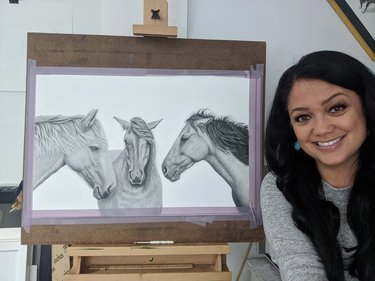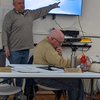The Lunar Codex aims to ‘spread hope during this dark time’ — Westerlo art to land on the moon
WESTERLO — Westerlo artist Tammy Liu-Haller, who draws stunningly realistic representations of nature, is having one of her works sent to the moon.
Her artwork, like that of some of the other selected artists, will be placed in two time capsules (one a redundancy), each of which will be attached to lunar landers, one expected to launch this summer, and the other to launch in autumn the following year.
Liu-Haller will also be among the first women whose art will live on the moon.
This special payload project is an effort taken on by Samuel Peralta, a doctor of physics — and an artist himself — who is also the executive chairman of the Canada-based company Incandence, which is overseeing the effort, known as the Lunar Codex.
Special payloads are loads carried on space-bound objects that are included by public and private organizations that tag along on whatever primary mission purposes the launch.
The cost of the project, which Peralta has borne himself, is “much less than buying a ticket to fly as an astronaut on one of Elon Musks’ or Jeff Bezos’ spaceships,” the physicist joked in an interview with The Enterprise this week.
The capsules themselves employ digital and analog technology to store their data; the analog capsules use NanoFiche technology, which can store 150,00 pages of material on a sheet the size of printer paper, while the digital capsules are more akin to a traditional memory card, the same kind that have been used by the National Aeronautics and Space Administration, according to the Lunar Codex website.
Contained in these capsules will be collections of art: primarily illustrative, but joined by “a substantial collection of contemporary books, stories, poetry, films, music, and more,” the website states, most all of which have been curated by Peralta himself.
Liu-Haller
Peralta came across Liu-Haller last year when he curated an exhibit in Chicago that called on artists to express that which offered them “tranquility, comfort, solace,” Peralta told The Enterprise this week.
“Tammy Liu-Haller submitted a piece to submissions call, a graphite and charcoal piece evoking the calm of beach pebbles, entitled ‘Snapshot Series #4: Solace.’ This was my first encounter with her work, and I was struck by the extraordinary calm evoked by the natural composition. That piece was selected for the exhibit.”
The entire exhibit would later be selected for inclusion in the time capsules.
For Liu-Haller, the experience is extraordinary. “It’s certainly an honor,” she told The Enterprise this week. “Dr. Peralta has curated the project himself, choosing the works that are included. And to know that something I created will exist in digital form on the moon is pretty amazing.”
Liu-Haller’s work will land on the moon’s Vallis Schröteri, she said, which is a raised land feature that sits within the Oceanus Procellarum, also known as the Ocean of Storms, which is most of the dark portion that can be seen on the light side of the moon. The second copy of her work will land on the moon’s south pole, according to a diagram that Peralta shared with The Enterprise.
“As an artist, my hope is to make art that reminds others of the beauty, strength, and intrigue that is found amongst nature and its animals. The moon landing allows my work to carry on with the hope that my drawing provides a small peek into the natural world on Earth.”
Liu-Haller was born in Kingston (Ulster County) and moved to Westerlo when her husband, a teacher, took a job nearby, she said. Although she has some education in art, she told The Enterprise that her current style is entirely self-taught, relying on social media to study other artists and adopt their practices herself, honing her craft slowly over the years.
“I’ve always admired realistic art over any other style, so it’s not a surprise that I gravitated toward wanting to create it,” she said.
That preference was serendipitous, since Peralta, too, finds himself attracted to representations that are more literal than abstract (though the capsules do contain abstract works, and many of the realistic offerings have impressionistic styles).
Liu-Haller told The Enterprise that her work “starts with a great reference photo. The more I can see, the more details I can draw. From there, the actual skill lies in knowing my materials and how to best use them to render the subject on paper. That part has taken me years to learn and I still have a long way to go.”
Her hardware includes pencils loaded with charcoal and graphite, “all with varying degrees of hardness,” she said, as well as blending tools and a variety of erasers.
“So, for example, the darkest shadows are going to call for a softer charcoal, whereas the lightest shades will require my hardest graphite pencils,” she explained. “Maybe I have to blend an area or perhaps it requires me to build up the illusion of texture. From there, I am simply drawing what I see in the reference photo.”
But, she said, “it’s not about drawing ‘this rock,’ but rather drawing ‘this shadow and these lines and that texture’ that make up the rock. Then stepping back and seeing it come together to form the image.”
An endless mission
It’s a natural impulse to ask what the practical reason for sending art to the moon is, where it will sit possibly forever, undisturbed by earthly phenomena like wind and precipitation that would otherwise degrade the materials encasing it, acting on very little and therefore hardly existing at all while it patiently awaits its next organic touch.
It’s also a question that might miss the point.
Still, Peralta explained to The Enterprise this week his ambitious yet simple purpose for attaching what is expected to be three capsules to various mooncraft — each sent by different organizations like SpaceX and NASA — over the next few years.
“The Lunar Codex, at its heart, is a project to spread hope during this dark time — the years of the COVID-19 pandemic on Earth — both for creative artists and those who love the arts,” Peralta said. “The project attempts to fill the moon with some of the heart of humanity, our art, so that when we look to the sky, the moon is a tangible symbol of hope, of what is possible when you believe.
“This is one reason we’ve focused on contemporary creative artists,” he said. “There are projects that archive the works of Shakespeare, or Michelangelo, or Beethoven; and rightly so, for they represent the pinnacle of human artistic achievement. This project focuses on the creativity of our generation, those making art through these troubled years, people like you and I.
“Thus, the Lunar Codex is also a message-in-a-bottle to the future, a snapshot of our generation. Our hope is that future travelers who find these time capsules will discover some of the richness of our world today. It speaks to the idea that, despite wars and pandemics and climate upheaval, humankind found time to dream, time to create art.”
In that way, the time capsules are an art themselves, inviting those aware of them to contemplate life after ourselves, not just a handful of generations from now, but a future so far off that humanity itself may no longer be around, possibly destroyed by the same relentless intellectual drive that brought us to the moon in the first place, the same that lets us create art and appreciate beauty only to then demand an answer from it.
It can be fun and humbling to think about how the art contained within the capsules will be received by the lifeforms that may find them. Will those forms be human, or some far-off descendant of the bottlenose dolphin; maybe a different animal that yet shows no clear intelligence? Maybe it will be creatures from beyond our solar system, arriving from another green world.
What’s the nature of the visual system that might be taking in the forms these artists have created or reproduced, and the colors that, for us, trigger certain memories and emotion? What might they mean to a different brain? Will they be thought impressive, or the rudiments of a culture of sometimes-noble savages? Will these works ever be seen at all?
Peralta’s is akin to another project that asks mankind to acknowledge the infinite expanse of time and our infinitesimal place within it, but from which we take actions that will reach beyond our own existence. That project, a clock that will keep time for 10,000 years, is overseen by a foundation called The Long Now, its name apparently taken from a small essay written by the British artist Brian Eno, who’s involved with the foundation.
Eno writes about visiting a friend’s lavish apartment in New York City in the ’70s that was hidden inside an ugly building in a poor neighborhood. Upon his inquiry about its strange placement, the friend explained she didn’t mind all that because, when she closed her doors and encased herself in her wealth, everything ugly had vanished.
“I noticed that this very local attitude to space in New York paralleled a similarly limited attitude to time,” wrote Eno. “Everything was exciting, fast, current, and temporary. Enormous buildings came and went, careers rose and crashed in weeks. You rarely got the feeling that anyone had the time to think two years ahead, let alone ten or a hundred. Everyone seemed to be passing through.
“It was undeniably lively, but the downside was that it seemed selfish, irresponsible and randomly dangerous,” he wrote. “I came to think of this as ‘The Short Now,’ and this suggested the possibility of its opposite — ‘The Long Now.’”
Peralta said his inspiration came from another spacebound project that was replete with symbolic value — the famous gold-and-aluminum records sent aboard the spacecrafts Pioneer 10 and 11, which host information about mankind and the Pioneer vessels, among other things. They were sent up to acknowledge the possibility of interception by intelligent life that might make sense of the data, to whatever effect.
Peralta also had a more terrestrial muse: “A personal inspiration was a ceramic vessel in the National Museum of the Philippines, where my father worked as an anthropologist,” he said. “It was inscribed with a poem that my father asked me to adapt from a rough transcription of the characters. My work ‘Inscription on a Chinese Ceramic Vessel’ was the poetic realization of that ancient inscription, from a time over a thousand years ago, and strengthened my realization that art could transcend time itself.”
Although much ambiguity surrounds the ultimate impact of these capsules, there are more prosaic and immediate uncertainties as well. As Peralta notes on his site, the launches are tentatively scheduled and won’t happen until they happen. Once they do, there’s no guarantee that they’ll reach their destination — though Peralta takes heart that a super-atmospheric failure will at least result in the art and everything else becoming stardust.
For the most literal-minded and goal-driven, who take pride in all the achievements made in our Short Now that can be observed and measured and discussed with little need for hypotheticals, all that ambiguity may leave too little to hang onto. But perhaps, taking inspiration from Eno, they can work through the implied humiliation of never knowing and find significance in its contraposition: endless wonder.



